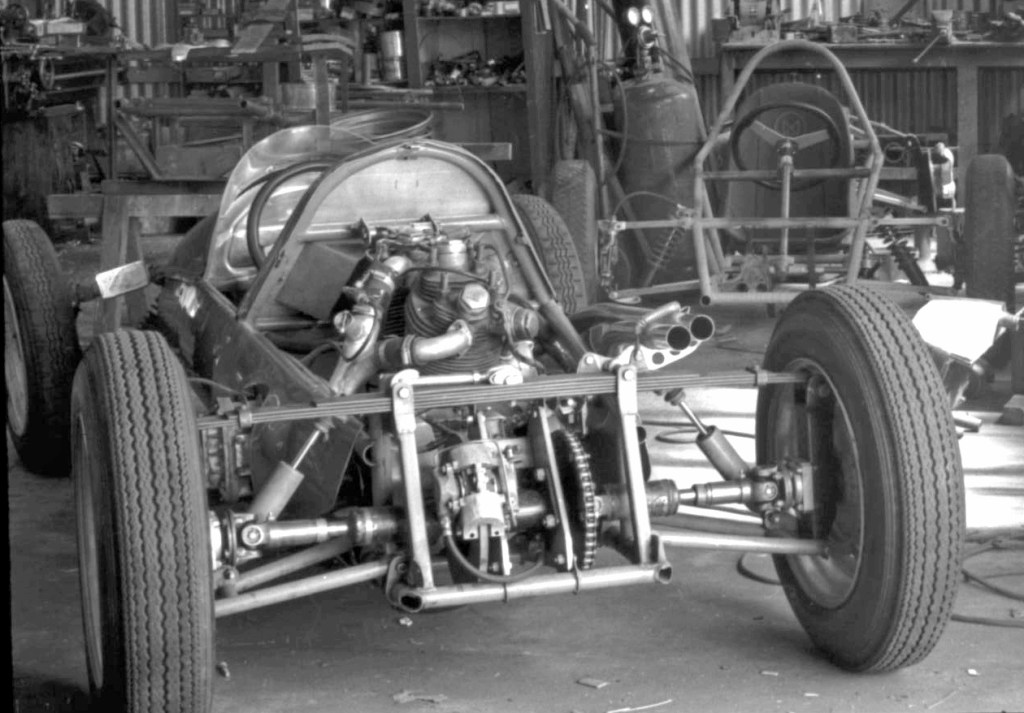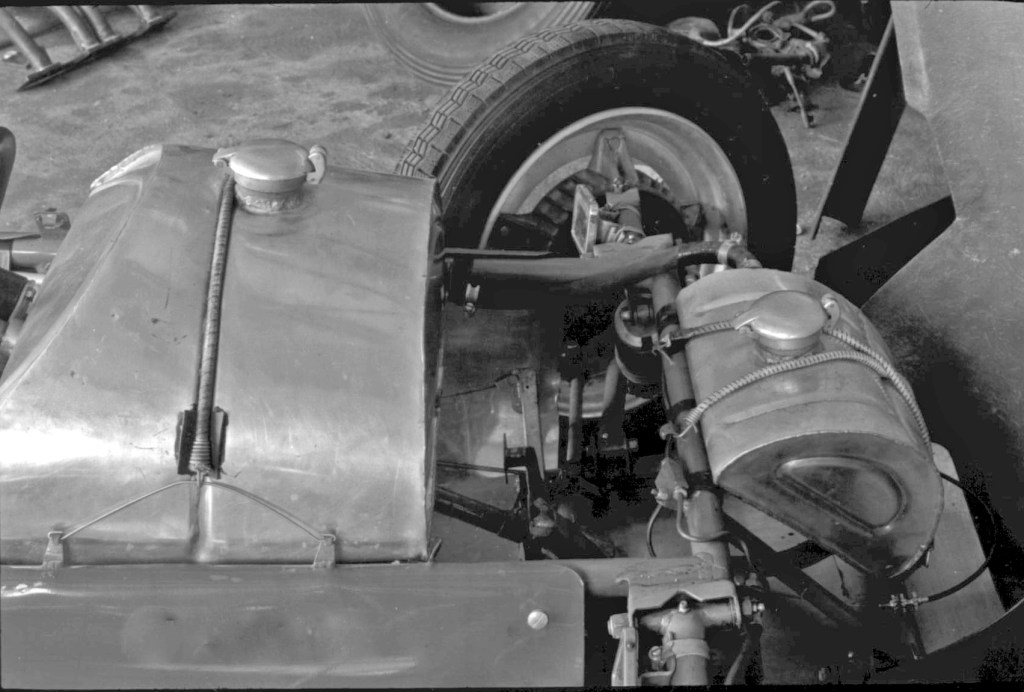Kerry Smith looks at Sydney’s LYNX ENGINEERING and the LYNX VINCENTS in the first of three articles.
In the June 1957 issue of Sports Car World, an article titled The Racing Ralts by Alan Gibbons featured the racing cars then being constructed by Ron and Austin Tauranac. Detailed was the last Ralt built in Sydney (#4) which was a rear-engined Cooper-style car with a 998cc Vincent engine. Ron raced it sporadically before selling it to Ossie and Noel Hall and then to Reg Mulligan who raced it regularly.
Between late 1957 and early to mid 1960, the Tauranacs produced a limited number of Ralts for clients, making five or maybe six chassis on their jig, before Ron joined Jack Brabham in the UK. Peter Wilkins, who had worked with Ron making chassis, fibreglass bodies and seats, alloy wheels with integral brake drums and steering and suspension gear bought the stock of parts.
Wilkins then sold this pile of Ralt goodies to John Bruderlin and Leon Thomas on Parramatta Road, Concord, Sydney. The pair specialized in racing very potent MG specials as well as selling MG parts from cars that they wrecked. Wilkins also joined the firm as a partner to help construct racing cars for the new Formula Junior class that was taking off at the time.
One of the goodies was a Ralt chassis with a rear disc brake, Ralt wheels and a Vincent twin engine nestled in the rear. A picture of this featured in an article with photos of a number of air-cooled racing cars which was taken in Centennial Park for the March 1960 Sports Car World. This author is certain that this was what became known as Lynx Vincent #1. An advert for ‘Lynx Engineering’ in Sports Car World of October 1960 gave the new business’s name and address, and the following month there was a Lynx advert for “Formula 1,2,3 and Junior cars, along with racing components and frames.

Lynx were to build three Vincent-engined cars which were well finished and potent vehicles. Later cars included the Lynx BMC/FJ, the Lynx Peugeot and a number of Ford-engined Junior cars (along with a quick supercharged car and a couple of nice Borgward engined Juniors). There was a relatively prolific output of cars from the factory over a period of probably two years at the most. They would have worked hard and smart.
How this hectic scene came about was probably due to Lynx utilizing the expertise of Peter Wilkins who later left to join up with Ron Tauranac and Jack Brabham constructing Brabhams in the UK. With Bruderlin’s and Thomas’ drive and expertise, along with the fabrication skills of Wilkins, electrician Phil Chittock and ex motorcyclist Stan Smith who was an ace aluminium alloy worker, the factory turned out cars with a quality finish plus the requisite speed.
The first Lynx to race and cause everyone to take notice was car #1 as driven by ex Victorian John Marston. He had previously raced the ex Lex Davison supercharged Mk4 Cooper Vincent and the Mk5 Cooper Irving (Vincent). The first Lynx race was at the opening Warwick Farm meeting in December 1960 which is well remembered because of the extremely wet conditions. The car was entered for John Bruderlin but for some reason Marston drove it; its performance was hampered by water getting into the engine. Marston then drove it for Lynx Engineering for the remainder of its time in Sydney.
Lynx #1, as we will call it, was a fairly simple design using contemporary Cooper and Ralt thinking, with a 998cc Vincent engine which was supercharged by a Roots-type cabin blower in the rear. There was a single disc brake on the chain driven back axle, a transverse rear leaf spring and lower wishbones. Ralt rack and pinion steering was used.
At the front were Ralt cast-alloy wheels with integral 8” brake drums and single, transverse upper suspension arms which had lower front wishbones and telescopic dampers. It mostly ran with Dunlop racing tyres. There was a fibreglass nose which was molded from a Mark 8 Cooper and a rear engine cover based on a T45 type Cooper with two large air scoops. It was painted mid blue. It was not a dissimilar design of car to the Davison Cooper Vincents or Bruce Walton’s supercharged Cooper JAP Mark 8 – a.k.a. the Walton-Cooper.

Through early 1961, the duo performed well at race tracks and more particularly the local hillclimb scene. Marston won the NSW hillclimb championship, just beating the late Jack Myers in the tangerine Thunderbird (twin S/C Triumph engines in a Ralt chassis). The Lynx was track tested at the Warwick Farm short circuit in early 1961 by Sports Car World’s Ian Fraser who was quite impressed by its performance.
In mid 1961, Lynx sold the now slightly tired #1 to Les Trim of Narrandera (NSW) who raced it consistently for a while at the country circuits of Victoria and NSW (including Hume Weir and Catalina Park). The car entered another phase when it was sold to a Victorian farmer, John Richardson. It featured in an SCW article in Aug/Oct 1978 by Noel Tuckey.
John Richardson fitted a S/C Cooper S engine/gearbox in the rear and clothed it in a Goggomobile Dart body and renamed the car RAB 2. The BMC power plant was replaced with a 179 Holden engine and VW gearbox. A Lola T70 front body was fitted with a Repco headed ‘grey’ Holden engine as a replacement. Then came new body work with a 3.3 litre Falcon engine and finally a P76 alloy V8 engine in 1973.
The 1961 sale to Les Trim led to the factory’s fevered construction from the ground up of Marston’s replacement Lynx #2 which will be the subject of the next episode of this ‘trilogy’.
KERRY SMITH
Photos courtesy the Australian Motor Heritage Foundation

Les Trim had a Vincent engined little car for dirt track racing prior to this. My father built it for him – there was such a track at Narrandera. For some reason, Les had a dispensation ? to race 1000cc in a 500cc class – he was a big lad !
As a 3 or 4 year old, I saw its inaugural race.
This would have been late 1950s ?
The sound and the fury was something to behold …
This car still exists – the new owner was chasing details.
LikeLike